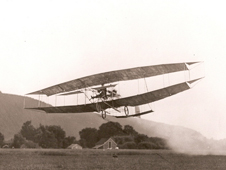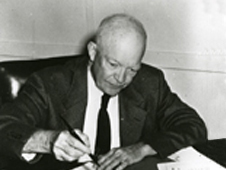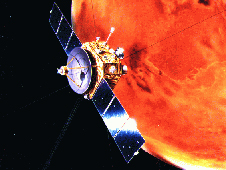Exploration
This Month in Exploration - July
07.01.08
 Glenn Curtiss flying the June Bug. Credit: Glenn H. Curtiss Museum, Hammondsport, NY
Glenn Curtiss flying the June Bug. Credit: Glenn H. Curtiss Museum, Hammondsport, NY
100 Years Ago
July 4, 1908: Glenn Curtiss completed the first pre-announced flight in America at Stony Brook Farm racetrack outside Hammondsport, N.Y. Curtiss flew the June Bug slightly less than a mile at about 34 miles per hour. He won the Scientific American Trophy for his flight and also received pilot license No. 1 from the Aero Club of America.
75 Years Ago
July 15 - 22, 1933: Wiley Post set a world record by flying solo around the globe in 7 days and 19 hours aboard the Winnie Mae.
50 Years Ago
July 29, 1958: President Eisenhower signed the National Aeronautics and Space Act of 1958, which instituted the National Aeronautics and Space Administration. NASA replaced the National Advisory Committee for Aeronautics, which was formed in 1915. NASA was officially open for business on October 1, 1958.
 President Dwight D. Eisenhower. Credit: U.S. Naval Photographic Center
President Dwight D. Eisenhower. Credit: U.S. Naval Photographic Center
30 Years Ago
July 14, 1978: The European Space Agency launched GEOstationary Scientific Satellite 2, also known as GEOS-2, to study Earth's magnetosphere. As a replacement for GEOS-1, GEOS-2 carried six antennas to measure changes in Earth's magnetic field.
25 Years Ago
July 26, 1983: NASA completed subsystems testing for Space Shuttle Discovery. This shuttle received final acceptance one month later and made its first flight in August 1984.
20 Years Ago
July 12, 1988: Russia launched Phobos 2 →, an unmanned satellite used to study Mars' largest moon, Phobos. Its sister probe, Phobos I, was launched on July 7. Phobos 2 contained instruments for studying the interplanetary environment, Mars, the sun and gamma-ray burst sources. The satellite gathered data until communication was lost a couple months after it reached Mars.
|
TO SUBSCRIBE: Get NASA's This Month in Exploration in your inbox every month. Send us an e-mail today. > Read More |
July 1, 1993: The Hubble Space Telescope first captured images of fragments of comet P/Shoemaker-Levy 9 with its planetary camera. One year later, the comet fragments collided with Jupiter. This was the first observed collision of bodies in our solar system.
10 Years Ago
July 3, 1998: Japan launched Nozomi → (Japanese for "hope") to begin its first interplanetary mission. Formerly known as Planet-B, Nozomi was built to study the atmosphere and ionosphere of Mars using 14 instruments from several nations. One of these instruments was the NASA Neutral Mass Spectrometer.
 Japan's Nozomi spacecraft. Credit: ISAS/JAXA
Japan's Nozomi spacecraft. Credit: ISAS/JAXA
Five Years Ago
July 7, 2003: NASA launched Opportunity, the second Mars Exploration Rover. Its sister spacecraft, Spirit, was launched June 10. Both rovers have retrieved valuable information regarding the composition of Martian soil and rocks as well as numerous high-quality images of the terrain for far longer than expected.
Present Day
July 20 - 23, 2008: As NASA prepares to return humans to the moon, the agency is encouraging dialogue about current and future lunar science studies. To facilitate this communication, a group of organizations hosted a lunar science conference → at the NASA Ames Conference Center in Moffett Field, Calif. This workshop included presentations about the history of the moon, the lunar environment and future lunar science opportunities.
July 2008: Scientists at NASA's Langley Research Center in Hampton, Va. are performing airbag drop testing at their Landing and Impact Research Facility. The testing will help further the development of a contingency landing system for the Orion crew exploration vehicle, which will carry astronauts to the moon. The landing system consists of two airbag assemblies that wrap around the front edge of Orion and enable both land and water landings.
Emily Owens (Analex Corporation)
See Past Issues:
> This Month in Exploration Main